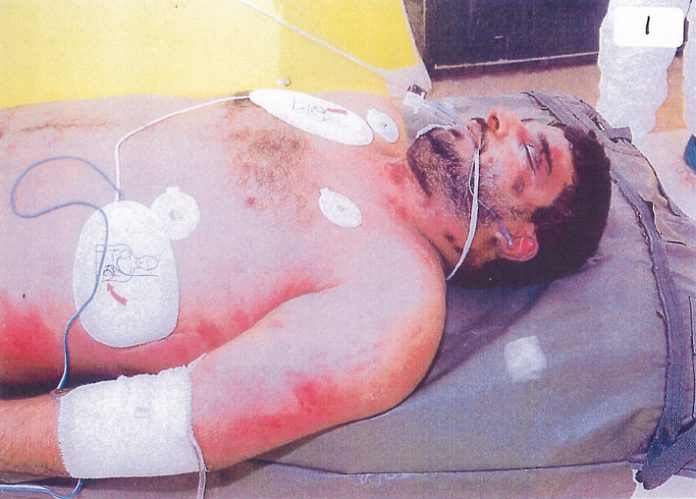
THE Blair government is challenging a High Court and Court of Appeal ruling that human rights law applies to the British army’s activities in Iraq and other countries.
The House of Lords case follows the death of hotel worker Baha Mousa in British military custody in Iraq four years ago in September 2003.
Phil Shiner, lawyer for Baha Mousa’s father, Colonel Daoud Mousa, presented photographic and medical evidence to a press conference at Westminster on Monday on the eve of the case, of which he said: ‘This is torture by any definition of that word.’
Shiner said the evidence had been suppressed until now because of a court martial hearing involving a number of British soldiers, at which the charges against them were dismissed.
But Shiner described the court martial as ‘a farce’ and ‘a travesty’.
He said the photographic and medical evidence showed that Baha Mousa and other Iraqi detainees had been systematically beaten and that techniques which were supposed to have been banned by the Heath government in 1972 were still being used by British forces in Iraq after the 2003 invasion.
Shiner also said the medical evidence indicated that Baha Mousa – contrary to claims to the opposite – had been deprived of food during his detention.
Shiner also said that the marks on his wrists indicated that plastic cuffs had been tied very tightly so that they cut into the skin, so there was no chance of him breaking free.
‘I suspect the plasticuffs had been tightened very, very hard indeed and this in itself will have caused a great deal of pain,’ Shiner said.
He said the material he was making public was disclosed by the Army Prosecuting Authority after the court martial hearing of several soldiers at Bulford ended.
‘He’s black and blue and there’s a ligament strangulation mark,’ Shiner said, as he held up photographs of detainee injuries in a Royal Military Police Special Investigation Branch supplement.
‘It does look as if someone did try to strangle him at some point,’ Shiner said.
‘All his injuries are described in some detail in the medical evidence,’ Shiner said.
He said the medical evidence indicated that Baha Mousa was so badly injured that he was left ‘bruised, I suspect, as much as a body will bruise.’
Shiner said the evidence was ‘highly relevant’.
Citing a Professor Mullroy, Shiner said that such a degree of bruising could cause the body to create a certain type of blood enzyme.
He said the ‘marker’ of this enzyme was present in both the body of Baha Mousa and another detainee who survived, Kifa al-Mutari.
(Kifa al-Mutari has since died).
He said the evidence suggested that Baha Mousa’s death was mainly the result of ‘this kind of treatment’.
He said the photographs and the medical evidence, in his view, were ‘very significant’ because they showed that ‘multiple injuries and in the last instance posteria asphyxia’ had killed Baha Mousa.
‘This repeated ill-treatment and bruising has nearly killed Kifa,’ Shiner added.
He also cited the photographic evidence of marks to the body of Sata Shukri Abdelah and Radif Taher Muslim, who were among the other Iraqi detainees.
He said the photographic evidence relating to Radif Taher Muslim showed ‘repeated impacts and bruising’.
‘It seems to me this man has been repeatedly kicked in the stomach,’ said Shiner, holding up more images.
He said a fifth detainee, Ahmed Maitham, had ‘a large area of bruising to his lower back’.
A sixth detainee, Jiwad Kamile Fayez, had a ‘bruised back and waist’ and a cut to his face.
Dr Hill – an ‘RAF man’, said Shiner – had expressed surprise that it had not been stitched.
Shiner said Dr Hill had described ‘in detail each of the 93 injuries’ to Baha Mousa, including a fractured nose and four broken ribs, which indicated that the hotel worker ‘would have been in pain and had difficulty breathing’.
Shiner said the medical evidence suggested that Baha Mousa met his end ‘having been starved for two days’ and after suffering ‘posteria asphyxia – someone’s got his knee in his back for a long period of time.’
He concluded: ‘This is torture by any definition of the word.’
He added that: ‘We’re also talking about techniques banned by the Heath government in 1972:
• ‘Hooding;
• ‘Sleep deprivation;
• ‘Stressing;
• ‘Food deprivation; and
• ‘White noise’.
He alleged that techniques such as banging a metal bar on the ground all night and ‘games’ in which soldiers kicked detainees who did not respond were used to deprive the Iraqi civilians held captive of sleep.
He said Dr Hill’s evidence suggested that there was an ‘absence of food in the stomach and small intestine’ of Baha Mousa, indicating that he had been starved as well as beaten during his detention.
‘Don’t we all need to know who was responsible?’ asked Shiner. ‘General Mike Jackson seems to think so.’
He also said someone ought to have known this incident was taking place over two days and that the Queen’s Lancashire Regiment should have known that the techniques they used had been banned.
He also suggested that this was just the ‘tip of an iceberg’, and that the allegations of abuse of Iraqi detainees at ‘Camp Bread Basket’ and the questions being asked about the treatment of interned Iraqis at Camp Bucca indicated this was by no means an isolated incident.
The press conference was attended by Liberty Director Shami Chakrabarti and MP Diane Abbott.
Shiner said that Daoud Mousa had spent a ‘week camped outside the British Embassy’ in Syria, trying to obtain a visa to get to Britain to attend the press conference, but to no avail.
He alleged that someone ‘high up’ may have blocked Daoud Mousa’s return to Britain, to avoid the ‘embarrassment’ to the British government of him presenting the photographic evidence of his son’s injuries to the world’s press in person.